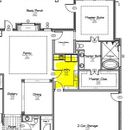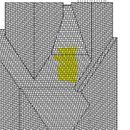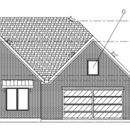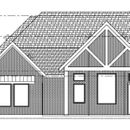best path for dryer vent exhaust pipe
While discussing with our HVAC guy regarding where the dryer exhaust pipe will go out to (roof vs side of house) he says he mostly vents it to the side. I am concerned that given that the utility room is smack in the middle of the house there would be angles to the duct path which might hinder proper exhausting. I also asked about perhaps needing a booster fan for the dryer venting? What would you recommend is the right approach to this setup? Attaching photos. Thanks so much.
GBA Detail Library
A collection of one thousand construction details organized by climate and house part














Replies
If it were my house, I would buy a heat pump drier that does not require venting. You could install an all-metal vent line as a backup or for future owners.
I second the heat pump dryer. With the dryer not on an outside wall, you'll end up with a long vent run, probably with a few elbows. I'd be concerned with fire risk from accumulation of lint and inability to clean the vent.
Hi Steve,
We are actually looking at purchasing a heat pump dryer. But we still would like the dryer vent as a backup in case the heat pump dryer is not a good fit for us. So what would you recommend for the vent path, straight up a roof or out to the side of the house, and booster fan or no booster fan?
Beedigs,
I think you've gotten good advice from the other posters. A booster fan sounds like one more failure point to me.
We had a condensing dryer in a previous house, and it did take a long time to cycle through. But it was never an issue for us, and my wife liked that the unit did not over-dry everything.
I never knew about heat pump dryers, per consumer reports:
https://www.consumerreports.org/laundry/energy-saving-laundry-tips-a9261296729/
But heat-pump dryers are expensive—and slow. Our tests found that the Whirlpool WHD862CHC hybrid, $1,800, used about 40 percent less energy when compared with a conventional Whirlpool electric dryer, but it took twice as long to dry our 12-pound test load of mixed cottons
My previous research on dryer vents thru roof confirmed this was likely a bad idea. For longer dryer vents the City of LA has guidelines for lengths greater than 14 feet:
1. The moisture exhaust duct shall be increased to 5 inches nominal diameter.
2. The total developed length of the 5 inch diameter duct shall not exceed 44 feet including two 90-degree elbows. 4 feet shall be deducted for each 90-degree elbow in excess of two.
3. Provide cleanouts that are accessible and are spaced not more than 20 feet apart, they shall also be located at the base of each vertical riser.
4. The termination of the duct shall not be restricted by any louvers or screens and the free area of the duct shall not be reduced.
5. The duct system design shall be such that the fasteners will not obstruct the flow through the duct system.
6. The lap joints are to be in the direction of air flow.
7. Ducts installed within a wall shall not be installed where the free area of the duct will be reduced.
8. The moisture exhaust duct shall not extend into or through ducts or plenums.
Personally, I'd go for the shortest path (accounting for bends - fewer the better), while maintaining accessibility for cleaning. In this case, I'd prefer going across near the back porch or out across the master bathroom side. Bal
I'd think putting it up through the roof would be worse for a few reasons:
- looks like a low slope shingle roof for a portion there so lint will want to collect on the roof/in the gutters/downspouts/etc.
- harder to see if the vent is clogging or blocked if it is up on the roof
- access for cleaning requires utilizing a ladder to then walk across the low slop roof area (which is more sensitive to any damage)
beedigs,
It looks from the plans as though y0u have a tray ceiling in the master suite. Why not run it through that and out the wall? It's a straight run and not very far.
Up to the ceiling and straight out the back wall. Or do a heat pump dryer. They cost more, take longer to dry and are more complicated machines, but they don't depressurize your house or create a fire hazard, and they cost less to operate.